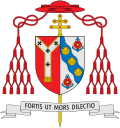Archbishop of Westminster
| Archbishop of Westminster | |
|---|---|
| Archbishopric | |
| catholic | |
 |
|
 |
|
| Incumbent: Cardinal Vincent Nichols |
|
| Province | Province of Westminster |
| Diocese | Diocese of Westminster |
| Cathedral | The Metropolitan Cathedral of the Most Precious Blood |
| First incumbent | Nicholas Wiseman |
| Formation | 1850 |
| Website | www.rcdow.org.uk/archbishop |
The Archbishop of Westminster heads the Roman Catholic Diocese of Westminster, in England. The incumbent is the Metropolitan of the Province of Westminster, Chief Metropolitan of England and Wales and, as a matter of custom, is elected President of the Catholic Bishops' Conference of England and Wales, and therefore de facto spokesman of the Catholic Church in England and Wales. All previous Archbishops of Westminster have become Cardinals. Although all the bishops of the restored diocesan episcopacy took new titles, like that of Westminster, they saw themselves in continuity with the pre-Reformation Church and post-Reformation Vicars Apostolic and Titular Bishops. Westminster, in particular, saw itself as the continuity of Canterbury, hence the similarity of the coat of arms of the two Sees, with Westminster believing it has more right to it since it features the pallium, a distinctly Catholic symbol of communion with the Holy See.
With the gradual abolition of the legal restrictions on the activities of Catholics in England and Wales in the early 19th century, Rome on its own ("not by Concordat with the British government nor conversations with the Anglican Church") decided to fill the partial vacuum, which Queen Elizabeth I had created, by restoring Catholic dioceses on a regular historical pattern and replacing existing titular bishops or Vicars Apostolic with diocesan ones. Thus Pope Pius IX issued the Bull Universalis Ecclesiae of 29 September 1850 by which thirteen new dioceses were created. Although these dioceses could not formally claim pre-Elizabethan territorial dioceses (owing to the Ecclesiastical Titles Act), they did claim validity and continuity with the pre-Elizabethan Church. Historian and descendant of recusants, Paul Johnson, claims that as early as 1718, only 30 years after the Glorious Revolution, Catholics could take heart when Parliament repealed the Schism Act, the Occasional Conformity Act and the Act for Quieting and Establishing Corporations, which allowed Dissenters to hold certain offices. Although these repeals at the time only benefited Dissenters, their rescission and abolition suggested reform was in the air and on Parliament's mind. Then in 1727, in the wake of the repeal of the annual Indemnity Acts, which relieved Dissenters of most of their civil disabilities (making it no longer possible, for example, to enforce by law the attendance of anyone at church on Sunday), Catholics, especially non-aristocratic Catholics, could slowly start to creep out into the open again, long before the Catholic Emancipation of 1832. As a result of the 1727 Act, Christianity in England (Anglican, Dissenter, Catholic, etc.) also ceased to be a "compulsory society". Still, Catholics had to wait another 95 years before being given full civil and religious rights. Nevertheless, the gains of the Dissenters a century earlier were a significant step towards eliminating Catholic disabilities later.
...
Wikipedia
